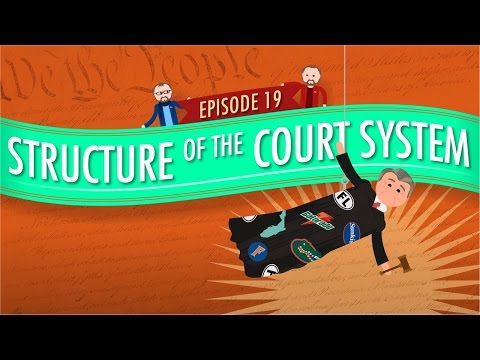
Understanding the Jurisdictional Hierarchy: The Courts for Civil Law Cases in the United States
Welcome to this informative article on the jurisdictional hierarchy of courts for civil law cases in the United States. As you embark on your journey to comprehend this intricate system, it is essential to remember that this article serves as a guide and should not replace the advice of legal professionals or further research. So, let’s dive into the fascinating world of American civil law courts!
In the United States, the jurisdictional hierarchy is structured in a way that ensures fair and efficient administration of justice. The system follows a pyramid-like structure, with each level maintaining its own jurisdictional authority and responsibilities.
📋 Content in this article
1. Federal Courts:
At the apex of the hierarchy, we find the federal courts. These courts primarily deal with cases involving federal laws, constitutional issues, or disputes between states. The United States Supreme Court, as the highest court in the land, sits atop this tier and has the final say on matters of federal law interpretation.
Below the Supreme Court are the United States Courts of Appeals, also known as circuit courts. These appellate courts review decisions made by lower federal courts. They are organized into 13 circuits, each covering specific geographical regions across the country.
Next, we have the United States District Courts. These trial courts are spread throughout the nation and handle both civil and criminal cases originating under federal law. District courts are often the first stop for most federal cases, including those involving constitutional rights, intellectual property disputes, and violations of federal regulations.
2. State Courts:
Directly beneath the federal court system, we have a network of state courts. These courts primarily handle cases that involve state laws or issues within a specific state’s jurisdiction. Each state has its own court structure, but they generally consist of trial courts, appellate courts, and a state supreme court.
Understanding the Hierarchy of Court Jurisdiction in the United States
Understanding the Jurisdictional Hierarchy: The Courts for Civil Law Cases in the United States
In the United States, the judicial system is organized in a hierarchical manner, with different levels of courts having varying degrees of jurisdiction. Jurisdiction refers to the authority of a court to hear and decide a particular type of case. It is essential to understand this hierarchy to navigate the legal system successfully.
1. State Courts:
a. Trial Courts:
– These are the lowest level of courts in the state system.
– They are also known as “lower” or “trial” courts.
– Each state has its own trial courts, which handle a wide range of civil law cases, including contract disputes, personal injury claims, family law matters, and more.
– Examples of trial courts include district courts, superior courts, and county courts.
b. Appellate Courts:
– These courts hear appeals from the trial courts.
– They review decisions made by the trial courts to ensure that errors of law were not made.
– Appellate courts do not retry cases; instead, they focus on reviewing legal arguments and determining if the trial court’s decision was correct.
– The decisions of appellate courts can set legal precedents that must be followed by lower courts.
– Examples of appellate courts include state courts of appeal and state supreme courts.
2. Federal Courts:
a. District Courts:
– These are the trial-level courts in the federal system.
– Each state is divided into one or more federal judicial districts, and each district has at least one district court.
– District courts have jurisdiction over federal civil cases involving issues such as federal law violations, constitutional rights, and disputes between citizens of different states (diversity jurisdiction).
– There are 94 district courts across the United States.
b. Circuit Courts of Appeals:
– These are the intermediate appellate courts in the federal system.
Understanding the Hierarchy and Jurisdictions within the US Judicial System
Understanding the Jurisdictional Hierarchy: The Courts for Civil Law Cases in the United States
The US judicial system is a complex and well-structured system that ensures justice is served. To understand how this system works, it is important to grasp the concept of jurisdictional hierarchy. Jurisdiction refers to the authority of a court to hear and decide certain types of cases. Each court in the US has its own jurisdiction, which is determined by factors such as the subject matter of the case, the parties involved, and the amount in dispute.
1. Federal Courts:
At the top of the jurisdictional hierarchy are the federal courts. These courts have authority over cases that involve federal laws, the Constitution, or disputes between parties from different states. The three main tiers of federal courts are:
2. State Courts:
Below the federal courts, each state has its own system of courts that handle matters not within federal jurisdiction. State courts have authority over cases involving state laws, regulations, and issues that are purely local in nature.
Title: Understanding the Jurisdictional Hierarchy: The Courts for Civil Law Cases in the United States
Introduction:
In the United States, the judicial system is structured hierarchically, with different levels of courts handling various types of cases. Understanding the jurisdictional hierarchy is essential for anyone involved or interested in civil law cases. This article aims to provide a comprehensive overview of the courts involved in civil law cases within the US, emphasizing the importance of staying current on this topic. Readers are strongly encouraged to verify and cross-reference the content provided here, as laws and regulations may change over time.
I. State Courts:
1. Trial Courts:
2. Intermediate Appellate Courts:
3. Highest State Court:
